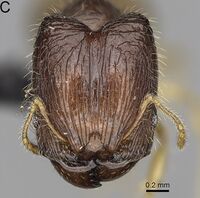Pheidole rugofitarata
| Pheidole rugofitarata | |
|---|---|

| |
| Scientific classification | |
| Kingdom: | Animalia |
| Phylum: | Arthropoda |
| Class: | Insecta |
| Order: | Hymenoptera |
| Family: | Formicidae |
| Subfamily: | Myrmicinae |
| Tribe: | Attini |
| Genus: | Pheidole |
| Species group: | makaensis |
| Species: | P. rugofitarata |
| Binomial name | |
| Pheidole rugofitarata Salata & Fisher, 2020 | |
The species was collected between 10–250 m in elevation, in rainforest and tropical dry forest. Nests were located in rotten logs.
Identification
Salata and Fisher (2020) - A member of the Pheidole makaensis species group. Major: Head in full-face view elongated; sides of the head with moderately dense, long, erect pilosity; occipital lobes indistinctly foveolate, with thick, sparse, short, transverse, and sometimes arcuate rugae; inner hypostomal teeth distinct, high, closely spaced, triangular, with rounded apex; outer hypostomal teeth wider and higher than inner hypostomal teeth, lobe-like.
Major workers. Pheidole rugofitarata is most similar to Pheidole fitarata and differs from it in presence of distinct and never-interrupted longitudinal rugae on frons and antennal scrobes, rugae on frons connected with rugae on occipital lobes, never entirely smooth genae, and lobe-like outer hypostomal teeth.
Keys including this Species
Distribution
Distribution based on Regional Taxon Lists
Malagasy Region: Madagascar (type locality).
Distribution based on AntMaps
Distribution based on AntWeb specimens
Check data from AntWeb
Countries Occupied
| Number of countries occupied by this species based on AntWiki Regional Taxon Lists. In general, fewer countries occupied indicates a narrower range, while more countries indicates a more widespread species. |

|
Biology
Castes
Major
Images from AntWeb

| |
| Worker (major/soldier). Specimen code casent0078206. Photographer Michele Esposito, uploaded by California Academy of Sciences. | Owned by CAS, San Francisco, CA, USA. |
Nomenclature
The following information is derived from Barry Bolton's Online Catalogue of the Ants of the World.
- rugofitarata. Pheidole rugofitarata Salata & Fisher, 2020: 128, figs. 47A–C, 85V, 88F (w.) MADAGASCAR.
Unless otherwise noted the text for the remainder of this section is reported from the publication that includes the original description.
Description
Worker
Major (N = 10): HL: 1.29-1.41 (1.36); HW: 1.05-1.17 (1.12); SL: 0.48-0.53 (0.5); EL: 0.14-0.17 (0.15); WL: 0.95-1.02 (0.99); PSL: 0.17-0.21 (0.18); MTL: 0.54-0.57 (0.55); PNW: 0.58-0.68 (0.62); PTW: 0.14-0.17 (0.16); PPW: 0.38-0.47 (0.43); CI: 81.2-85.8 (82.9); SI: 41.8-49.0 (44.3); PSLI: 12.2-15.2 (13.5); PPI: 34.0-42.1 (37.3); PNI: 53.1-59.0 (55.3); MTI: 46.9 -52.5 (49.1). Head. In full-face view longitudinal, longer than wide, anterior of eyes straight, posterior of eyes slightly convex, occipital margin of lobes straight, inclining toward centre. In lateral view sub-oval; ventral and dorsal faces convex; dorsal face not depressed posteriorly; inner hypostomal teeth visible. Sides of the head with moderately dense, long, erect pilosity; whole head with moderately dense, long, suberect to erect pilosity. Antennal scrobes indistinct and not delimited by carinulae; scrobe surface shiny, with moderately dense, longitudinal rugae, interspaces superficially foveolate. Occipital lobes shiny, indistinctly foveolate, with thick, sparse, short, transverse and sometimes arcuate rugae; frons with moderately dense, thick, longitudinal rugae, interspaces smooth and indistinctly foveolate on the posterior part; genae shiny, with dense, thin, longitudinal rugulae and smooth notch in the centre; malar area with thick, longitudinal, moderately sparse rugae, interspaces smooth. Centre of clypeus shiny and smooth, lateral sides with longitudinal rugae; median notch present, wide and shallow; median longitudinal carina absent; lateral longitudinal carinae absent. Scape, when laid back, not reaching the midlength of head; pilosity suberect to erect. Inner hypostomal teeth distinct, high, closely spaced, triangular, with rounded apex; outer hypostomal teeth wider and higher than inner hypostomal teeth, lobe-like. Mesosoma. In lateral view, promesonotum relatively low and arched, posterior mesonotum relatively steep, with tubercle-like projections; promesonotal groove absent; metanotal groove indistinct; propodeal spines moderately long, triangular, with sharp apex and wide base; humeral area laterally weakly produced. Surface finely foveolate with additional irregular, thin, and sparse rugoreticulation; dorsal surface of promesonotum with fading foveolae and thin, sparse, and transverse rugulae; katepisternum with reduced sculpture. Pilosity moderately dense, very long and erect. Petiole. Shiny; peduncle moderately long, finely foveolate, with indistinct horizontal lobes on its basal part; node smooth, relatively high, triangular, with rounded apex, in rear view node slightly convex; pilosity long and erect. Postpetiole. Shiny and finely shagreened, dorsum with fading sculpture; in dorsal view sides with moderately short, acute, and triangular projections; pilosity long and erect. Petiole. Shiny and finely shagreened; pilosity dense, long, and erect. Colour. Reddish brown to brown, lateral sides of mesosoma and legs yellowish brown.
Unless otherwise noted above, the following characters occur in this species, and the majority of Pheidole majors of Madagascar described by Salata and Fisher 2020a. Antennal sockets shallow; frontal lobes absent; head in full-face view with distinct median concavity; antenna 12-segmented, with 3-segmented club; masticatory margin of mandible with large, stout apical and preapical teeth, followed by a long diastema and then a short and crenulate tooth just before the rounded basal angle; outer surface of mandible mostly smooth and shining, sometimes with weak and sparse foveolae; antennal scrobes present; promesonotum strongly convex, well above the level of propodeum; postpetiole short with slightly convex dorsum; ventral process absent.
Minor workers. Unknown.
Type Material
Holotype. Madagascar. 1 major worker; Mahajanga; Parc National Tsingy de Bemaraha, 2.5 km 62°ENE Bekopaka, Ankidrodroa River; -19.13222, 44.81467; alt. 100 m; 11 Nov 2001; Fisher et al. leg.; BLF04341, CASENT0078206 (California Academy of Sciences). Paratype. Madagascar. 1s.; same data as for holotype; CASENT0078208 (CASC).
Etymology
Similar to Pheidole fitarata, but with more distinct head sculpture in major workers.
References
- Casadei-Ferreira, A., Fischer, G., Economo, E.P. 2020. Evidence for a thoracic crop in the workers of some Neotropical Pheidole species (Formicidae: Myrmicinae). Arthropod Structure, Development 59, 100977 (doi:10.1016/J.ASD.2020.100977).
- Salata, S. and B.L. Fisher. 2020a. Pheidole Westwood, 1839 (Hymenoptera, Formicidae) of Madagascar – an introduction and a taxonomic revision of eleven species groups. ZooKeys. 905:1–235. doi:10.3897/zookeys.905.39592
